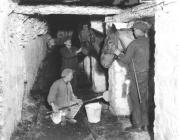Welsh colliery horses
Items in this story:
Pit ponies
Horses have been closely connected with coal mining since the early days of the industry. They have been used to transport coal from the collieries to the customer, have been used to power winding and pumping engines and, most importantly, to move coal from the coalface to the shaft.
In 1878 the RSPCA calculated that there were over 200,000 at work in British mines.
Although often referred to as 'pit ponies' by the general public, most of the animals used in Welsh collieries were actually horses.
15 hands high
They were usually around 15 hands high (a hand being 10cms with horses being measured to the shoulder). However some ponies, of about 13 hands, were used for light haulage duties.
The best looking colliery horses would be exhibited in shows, with collieries competing with each other for the champion horse. Such 'show horses' usually led a very privileged life, often kept on light duties to preserve their appearance.
Inhumaine or essential to economic growth?
Although they were essential for the production of coal before the introduction of mechanised haulage, the use of horses in the coal industry has often been highly controversial.
The coal owners argued that they were vital in the economic process of winning coal while animal lovers regarded their use as inhumane.
In between these opposing sides were the mineworkers, who may have felt sympathy for these animals. However they could turn a blind eye to any callousness, or even be cruel themselves, if their pay packets were under threat.
Whether he was a 'willing pet' or a 'wretched pit pony' the colliery horse shared the same conditions and dangers as the coalminer; they were used as a propaganda tool by both sides during industrial disputes, they died in their hundreds from mistreatment, accident and explosion - but without their hard work, the industrial revolution would have failed.
Hard graft
Whether he was a 'willing pet' or a 'wretched pit pony' the colliery horse shared the same conditions and dangers as the coalminer; they were used as a propaganda tool by both sides during industrial disputes, they died in their hundreds from mistreatment, accident and explosion - but without their hard work, the industrial revolution would have failed.
I remember Edgar, a little haulier, who used to say to his horse every morning 'Are you going to work for me today?' Then he'd give him an apple. They were more butties (mates) than workman and horse!
Len Howell, Six Bells Colliery, 1960s
Placed in the hands of ignorant lads who shamefully abused the powers entrusted to them without fear of punishment, worked often in double shifts of sixteen consecutive hours ... the horses are ... kept below ground for years without seeing daylight, left without any form of inspection worthy of the name, their lives were a standing outcry against cruelty and injustice.
The Animal World, September 1918



